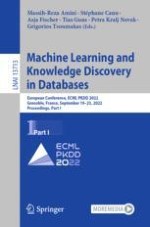The multi-volume set LNAI 13713 until 13718 constitutes the refereed proceedings of the European Conference on Machine Learning and Knowledge Discovery in Databases, ECML PKDD 2022, which took place in Grenoble, France, in September 2022.
The 236 full papers presented in these proceedings were carefully reviewed and selected from a total of 1060 submissions. In addition, the proceedings include 17 Demo Track contributions.
The volumes are organized in topical sections as follows:
Part I: Clustering and dimensionality reduction; anomaly detection; interpretability and explainability; ranking and recommender systems; transfer and multitask learning;
Part II: Networks and graphs; knowledge graphs; social network analysis; graph neural networks; natural language processing and text mining; conversational systems;
Part III: Deep learning; robust and adversarial machine learning; generative models; computer vision; meta-learning, neural architecture search;
Part IV: Reinforcement learning; multi-agent reinforcement learning; bandits and online learning; active and semi-supervised learning; private and federated learning; .
Part V: Supervised learning; probabilistic inference; optimal transport; optimization; quantum, hardware; sustainability;
Part VI: Time series; financial machine learning; applications; applications: transportation; demo track.
